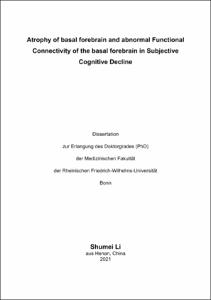Li, Shumei: Atrophy of basal forebrain and abnormal Functional Connectivity of the basal forebrain in Subjective Cognitive Decline. - Bonn, 2021. - Dissertation, Rheinische Friedrich-Wilhelms-Universität Bonn.
Online-Ausgabe in bonndoc: https://nbn-resolving.org/urn:nbn:de:hbz:5-61450
Online-Ausgabe in bonndoc: https://nbn-resolving.org/urn:nbn:de:hbz:5-61450
@phdthesis{handle:20.500.11811/8949,
urn: https://nbn-resolving.org/urn:nbn:de:hbz:5-61450,
author = {{Shumei Li}},
title = {Atrophy of basal forebrain and abnormal Functional Connectivity of the basal forebrain in Subjective Cognitive Decline},
school = {Rheinische Friedrich-Wilhelms-Universität Bonn},
year = 2021,
month = mar,
note = {Subjective Cognitive Decline (SCD) is increasingly recognized as an efficient concept to study in an early preclinical stage of Alzheimer’s disease (AD). It is marked by a perceived subjective worsening of cognitive function compared to the earlier performance level without noticeable impairments in standard neuro-psychological testing. Even though SCD individuals do not necessarily share the same underlying AD pathology, a variety of studies have identified an increased AD biomarker positivity and risk to develop clinical AD. SCD also show atrophy in regions that are known to be vulnerable to AD-pathology (i.e. hippocampus, entorhinal cortex, precuneus). Recent studies suggest that cholinergic basal forebrain (BF) volume loss even precedes degeneration of the entorhinal cortex.
This thesis focusses on the question how BF-atrophy relates to amyloid pathology in SCD and healthy controls and tried to further investigate the functional consequences as assessable by resting state functional MRI. The three conducted studies are based on German Center for Neurodegenerative Diseases Longitudinal Cognitive Impairment and Dementia Study (DELCODE) project. Study 1 examined cholinergic BF volume alterations in SCD. A significant interaction between diagnosis (SCD vs. Healthy control [HC]) and CSF amyloid status was found, with posterior of NBM volume reductions only in amyloid-positive SCD. The observed volume reduction of the cholinergic BF in amyloid-positive SCD and the absence of any volume reductions in the amyloid-positive HC suggests that SCD plus amyloid pathology reflects an advanced stage of preclinical AD, revealing the beginning neurodegeneration on a macroscopic level. The second study revealed that the degeneration of the BF alters the functional connectivity to certain cortical brain regions. More or less the overall trend observed was a reduced connectivity. Based on a group stratification with respect to cortical amyloid deposition, the alteration of the functional connectivity of the precuneus was investigated in Study 3. Compared to amyloid-negative SCD, significantly higher regional homogeneity within the precuneus was found for amyloid-positive SCD as well as a higher FC to occipital areas.
Taking everything together, the presented data indicate that the cholinergic system, especially the posterior part of the NBM (Ch4p) seems to play a key role in the very early stage of AD. It affects not only memory processes but has also a ‘long range effect’ leading to decreased FC. SCD appears to be a hallmark on the AD-trajectory marking the point when neurodegenerative process begins to exceed a level that can’t be functionally compensated, and therefore amyloid-positive SCD might reflect the progression from an asymptomatic stage (stage 1) to stage 2 of the Alzheimer’s continuum, where cognitive functions start to impairment.},
url = {https://hdl.handle.net/20.500.11811/8949}
}
urn: https://nbn-resolving.org/urn:nbn:de:hbz:5-61450,
author = {{Shumei Li}},
title = {Atrophy of basal forebrain and abnormal Functional Connectivity of the basal forebrain in Subjective Cognitive Decline},
school = {Rheinische Friedrich-Wilhelms-Universität Bonn},
year = 2021,
month = mar,
note = {Subjective Cognitive Decline (SCD) is increasingly recognized as an efficient concept to study in an early preclinical stage of Alzheimer’s disease (AD). It is marked by a perceived subjective worsening of cognitive function compared to the earlier performance level without noticeable impairments in standard neuro-psychological testing. Even though SCD individuals do not necessarily share the same underlying AD pathology, a variety of studies have identified an increased AD biomarker positivity and risk to develop clinical AD. SCD also show atrophy in regions that are known to be vulnerable to AD-pathology (i.e. hippocampus, entorhinal cortex, precuneus). Recent studies suggest that cholinergic basal forebrain (BF) volume loss even precedes degeneration of the entorhinal cortex.
This thesis focusses on the question how BF-atrophy relates to amyloid pathology in SCD and healthy controls and tried to further investigate the functional consequences as assessable by resting state functional MRI. The three conducted studies are based on German Center for Neurodegenerative Diseases Longitudinal Cognitive Impairment and Dementia Study (DELCODE) project. Study 1 examined cholinergic BF volume alterations in SCD. A significant interaction between diagnosis (SCD vs. Healthy control [HC]) and CSF amyloid status was found, with posterior of NBM volume reductions only in amyloid-positive SCD. The observed volume reduction of the cholinergic BF in amyloid-positive SCD and the absence of any volume reductions in the amyloid-positive HC suggests that SCD plus amyloid pathology reflects an advanced stage of preclinical AD, revealing the beginning neurodegeneration on a macroscopic level. The second study revealed that the degeneration of the BF alters the functional connectivity to certain cortical brain regions. More or less the overall trend observed was a reduced connectivity. Based on a group stratification with respect to cortical amyloid deposition, the alteration of the functional connectivity of the precuneus was investigated in Study 3. Compared to amyloid-negative SCD, significantly higher regional homogeneity within the precuneus was found for amyloid-positive SCD as well as a higher FC to occipital areas.
Taking everything together, the presented data indicate that the cholinergic system, especially the posterior part of the NBM (Ch4p) seems to play a key role in the very early stage of AD. It affects not only memory processes but has also a ‘long range effect’ leading to decreased FC. SCD appears to be a hallmark on the AD-trajectory marking the point when neurodegenerative process begins to exceed a level that can’t be functionally compensated, and therefore amyloid-positive SCD might reflect the progression from an asymptomatic stage (stage 1) to stage 2 of the Alzheimer’s continuum, where cognitive functions start to impairment.},
url = {https://hdl.handle.net/20.500.11811/8949}
}






